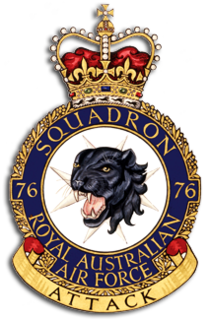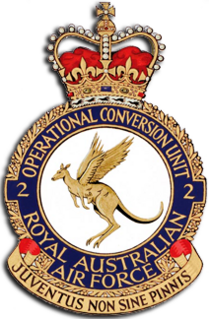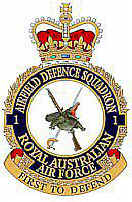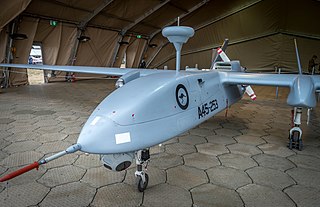Related Research Articles
The Airfield Defence Guard (ADG) mustering of the Royal Australian Air Force (RAAF) performs specialist ground defence tasks to protect air power assets from hostile ground action. The mustering is composed of non-commissioned members, commonly called 'ADGies,' most of whom are employed within a Security Forces (SECFOR) Squadron (SQN). Their primary role is the protection of RAAF equipment, personnel, assets and facilities during operations. While ADGs train to counter special forces as the primary ground threat to the projection of air power, ADGs are themselves conventional forces. Other duties include training RAAF personnel in weapon handling and basic ground defence tactics.

RAAF Base Richmond is a Royal Australian Air Force (RAAF) military air base located within the City of Hawkesbury, approximately 50 kilometres (31 mi) North-West of the Sydney Central Business District in New South Wales, Australia. Situated between the towns of Windsor and Richmond, the base is the oldest base in New South Wales and the second oldest in Australia. The base is home to the transport headquarters RAAF Air Lift Group, and its major operational formations, Nos. 84 and 86 Wings. The main aircraft type operated at the base is the Lockheed C-130 Hercules. Richmond is a regular venue for air shows and had at times been mooted as a site for Sydney's proposed second international airport.

The Royal Australian Air Force's No 1 Combat Communications Squadron (1CCS), is a Squadron within 95 Wing and is responsible for the provision of expeditionary Communications and Information Systems (CIS) to support Air Force and Australian Defence Force operations and exercises.

No. 3 Squadron is a Royal Australian Air Force (RAAF) fighter squadron, headquartered at RAAF Base Williamtown, near Newcastle, New South Wales. Established in 1916, it was one of four combat squadrons of the Australian Flying Corps during World War I, and operated on the Western Front in France before being disbanded in 1919. It was re-raised as a permanent squadron of the RAAF in 1925, and during World War II operated in the Mediterranean Theatre. The Cold War years saw the squadron disbanded and re-raised twice. It was based at RAAF Butterworth during the Malayan Emergency and the Indonesia–Malaysia Konfrontasi. Equipped with McDonnell Douglas F/A-18 Hornet multi-role fighters from 1986, the squadron deployed to Diego Garcia in 2002 to provide local air defence, and the following year contributed aircraft and crews to the invasion of Iraq as part of Operation Falconer. In April 2016, it deployed to the Middle East as part of the military intervention against ISIL.

No. 76 Squadron is a Royal Australian Air Force (RAAF) flight training squadron. Established in 1942, it operated P-40 Kittyhawk fighter aircraft in the South West Pacific theatre during World War II. Following the end of hostilities it re-equipped with P-51 Mustangs and formed part of Australia's contribution to the occupation of Japan until disbanding in 1948. The squadron was re-formed in 1949 and three years later transferred to Malta, where it operated de Havilland Vampire jet fighters on garrison duty until again disbanding in 1955. It was reactivated in 1960 and operated CAC Sabre and Dassault Mirage III fighters in Australia until 1973. No. 76 Squadron was re-formed in its present incarnation in 1989 and is currently stationed at RAAF Base Williamtown, New South Wales, where it operates Hawk 127 jet training aircraft.

No. 2 Operational Conversion Unit is a fighter training unit of the Royal Australian Air Force (RAAF). Located at RAAF Base Williamtown, New South Wales, the unit trains pilots to operate the McDonnell Douglas F/A-18 Hornet, conducts refresher courses for pilots returning to the type, and trains future Hornet instructors. Pilots new to the Hornet enter No. 2 OCU after first qualifying to fly fast jets at No. 79 Squadron and undertaking initial fighter combat instruction at No. 76 Squadron. Once qualified on the F/A-18, they are posted to one of No. 81 Wing's operational Hornet units, No. 3 Squadron, No. 75 Squadron or No. 77 Squadron.

No. 4 Squadron is a Royal Australian Air Force squadron composed of the air force special forces Combat Controllers, aircrew who operate the Pilatus PC-21 aircraft and instructors for the Australian Defence Force Joint Terminal Attack Controller (JTAC) course.

No. 102 Squadron was a Royal Australian Air Force (RAAF) heavy bomber squadron of World War II. The squadron was only active for less than nine months before being disbanded. No. 102 Squadron was formed at Cecil Plains, Queensland on 31 May 1945. The Squadron's B-24 Liberator bombers arrived in July. While the Squadron began training on these aircraft, the war ended before it reached operational status. Following the end of the war the squadron operated in the transport role until December 1945. No. 102 Squadron was disbanded on 19 March 1946.

No. 453 Squadron is an air traffic control unit of the Royal Australian Air Force. It was established at Bankstown, New South Wales, in 1941 as a fighter squadron, in accordance with Article XV of the Empire Air Training Scheme for overseas service with the Royal Air Force during World War II. No. 453 Squadron saw combat first in the Malayan and Singapore campaigns of 1941–42. Severe aircraft losses effectively destroyed the squadron and it was disbanded in March 1942. A successor unit by the same name was raised in Britain from mid-1942, to take part in fighting against Nazi Germany in Europe until 1945. The squadron was disbanded in 1946. It was re-formed in its current role in 2011.

No. 86 Wing is a Royal Australian Air Force (RAAF) transport and air-to-air refuelling wing. Coming under the control of Air Mobility Group, it is headquartered at RAAF Base Amberley, Queensland. The wing comprises No. 33 Squadron, operating Airbus KC-30 tanker-transports, No. 36 Squadron, operating Boeing C-17 Globemaster III heavy transports, and the Australian Army's 68 Ground Liaison Section. Its aircraft support Australian military and humanitarian operations worldwide.

The Royal Australian Air Force's Air Combat Group (ACG) is the group which administers the RAAF's fighter and bomber aircraft. ACG was formed on 7 February 2002 by merging the RAAF's Tactical Fighter Group and Strike Reconnaissance Group in an attempt to improve the speed with which the RAAF can deploy its combat aircraft. The current commander of ACG is Air Commodore Anthony Grady.

No. 78 Wing is a Royal Australian Air Force (RAAF) operational training wing, headquartered at RAAF Base Williamtown, New South Wales. It comprises Nos. 76 and 79 Squadrons, operating the BAE Hawk 127 lead-in fighter, and No. 278 Squadron, a technical training unit. No. 79 Squadron, located at RAAF Base Pearce, Western Australia, is responsible for converting new pilots to fast jets, while No. 76 Squadron at Williamtown conducts introductory fighter courses; both units also fly support missions for the Royal Australian Navy and the Australian Army.

No. 81 Wing is responsible for operating the McDonnell Douglas F/A-18 Hornet multi-role fighters of the Royal Australian Air Force (RAAF). Headquartered at RAAF Base Williamtown, New South Wales, the wing comprises three combat units, Nos. 3 and 77 Squadrons based at Williamtown and No. 75 Squadron at RAAF Base Tindal, Northern Territory, as well as an operational conversion unit at Williamtown. No. 81 Wing headquarters oversees squadron training in air-to-air and air-to-ground tactics, and support for the Australian Army and Royal Australian Navy. Tasked with offensive and defensive counter-air operations, the Hornets have been deployed to Diego Garcia in 2001–02, when they provided local air defence, to Iraq in 2003, when they saw action flying fighter escort and close air support missions in concert with Coalition forces, and to the Middle East in 2015–16, when they undertook strike operations during the military intervention against ISIL. They have also been employed to patrol high-profile events in Australia, including the Commonwealth Games and visits by foreign dignitaries.

No. 82 Wing is the strike and reconnaissance wing of the Royal Australian Air Force (RAAF). It is headquartered at RAAF Base Amberley, Queensland. Coming under the control of Air Combat Group, the wing operates F/A-18F Super Hornet multirole fighters and Pilatus PC-9 forward air control aircraft. Its units include Nos. 1 and 6 Squadrons, operating the Super Hornet, and No. 4 Squadron, operating the PC-9.

No. 42 Wing is a Royal Australian Air Force (RAAF) wing responsible for supporting the service's Boeing E-7A Wedgetail aircraft. It was first formed in February 1943, and commanded RAAF radar stations in north Queensland and the south coast of Dutch New Guinea until being disbanded in October 1944. It was re-raised in its current role in 2006.

No. 1 Security Forces Squadron (1SECFOR) is a Royal Australian Air Force (RAAF) military unit whose primary role is to protect and secure airfields, buildings, equipment, and personnel.

No. 5 Operational Training Unit was an operational training unit (OTU) of the Royal Australian Air Force. It was formed at Wagga Wagga, New South Wales, in October 1942 to train pilots and navigators for service in World War II. The unit was initially equipped with Bristol Beauforts and Beaufighters, and later received Douglas Bostons and de Havilland Mosquitos, among other types. No. 5 OTU was transferred to Tocumwal in October 1943, and then to Williamtown in mid-1944. It was reorganised as a fighter conversion unit flying P-51 Mustangs and CAC Wirraways in February 1946, and disbanded in July 1947.

No. 5 Flight was a Royal Australian Air Force (RAAF) aircraft flight which was equipped with IAI Heron unmanned aerial vehicles. It was established in 2010 to operate Herons in Afghanistan. Following the withdrawal of the Heron detachment from that country in 2014, conducted training missions in Australia to maintain the RAAF's expertise in operating unmanned aerial vehicles until more advanced types are delivered. The Herons were retired in June 2017, and the flight was disbanded by the end of that year.
Lincoln Conversion Flight was a Royal Australian Air Force (RAAF) training unit. The flight was formed in July 1955 to provide operational conversion training on the Avro Lincoln heavy bomber and was disbanded in March the next year.

No. 1 Operational Conversion Unit (No. 1 OCU) was an operational training unit of the Royal Australian Air Force (RAAF). Formed in January 1959 at RAAF Base Amberley, Queensland, its role was to convert pilots and navigators to the English Electric Canberra bombers flown by Nos. 1, 2 and 6 Squadrons. The unit's complement of Canberras included T.4 and Mk.21 dual-control trainers, and Mk.20 bombers. Originally a component of No. 82 Wing, No. 1 OCU became an independent unit at Amberley in April 1968, its focus being the provision of operationally ready pilots for service with No. 2 Squadron in the Vietnam War. No. 1 OCU was disbanded in June 1971, following the withdrawal of No. 2 Squadron from South-East Asia. By then the RAAF's only Canberra unit, No. 2 Squadron ran its own conversion courses before disbanding in 1982.
References
- ↑ "Photograph S20203988". Department of Defence. Retrieved 8 January 2021.
This article does not cite any sources .(April 2008) (Learn how and when to remove this template message) |